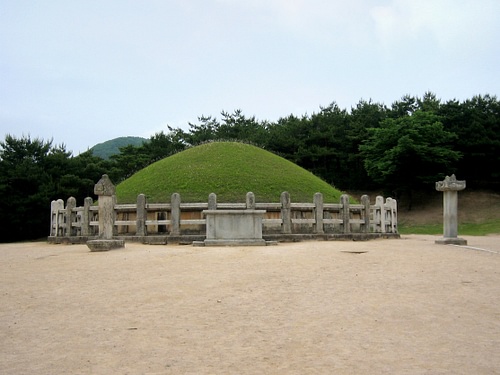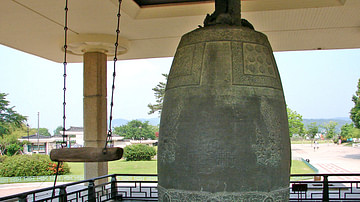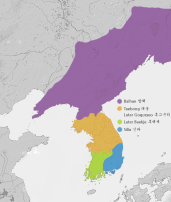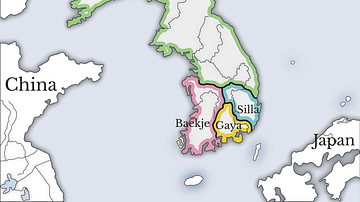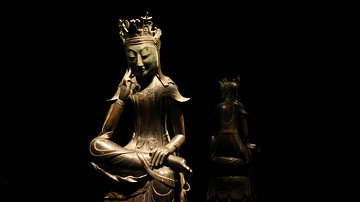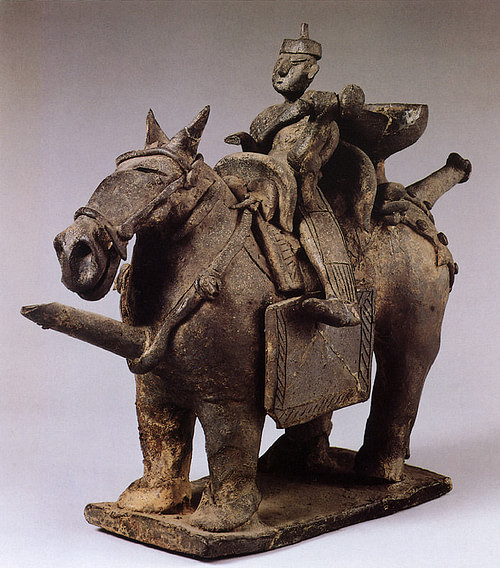
Kim Yu-sin (aka Kim Yushin, 595-673 CE) was a general of the Silla kingdom which ruled south-eastern Korea during the Three Kingdoms Period. Kim would greatly help Silla unify Korea, famously leading a massive army to crush the rival kingdom of Baekje (Paekche) in the 660's CE. His feats won him legendary status in his own lifetime, an elevated position he still enjoys in Korea today.
Early Life & Legends
Kim was a descendant of the royal house of Gaya (Kaya), a confederation which ruled to the west of the Silla kingdom from 42 to 532 CE before it was conquered by its more powerful neighbour. Various legends concerning Kim appear in the Samguk sagi ('Historical Records of the Three States') written in 1146 CE by Gim Busik. One such legend has it that before his birth his father dreamed of the planets Saturn and Mars falling on top of him while his mother dreamed that a small boy came into her room wearing brilliantly shining golden armour while he floated on a cloud, both powerful omens of his future glittering military career.
At the age of 14 he joined the hwarang ('Flower Boys'), a Silla group of elite teenagers who sang and danced and studied the principles of Confucianism and Buddhism. Kim Yu-sin's particular group was known as the 'Band of the Dragon Flower Tree,' and Kim was reportedly a model of good deeds and spirituality. Another legend from the Samguk sagi tells of the time Kim entered a cave in the mountains at age 16. After purifying himself and praying for four days, he swore to heaven that he would battle and defeat the kingdom of Goguryeo (Koguryo) and the Malgal tribes of the north. An old man then sees the young Kim and, on hearing of his resolve, gives him a magic formula of unknown description. One year later Kim, now in a deep valley, goes through the same process and asks the heavens for his sword to be given special powers. After three days a light shines down from the skies and the sword shakes. These legends help to explain the great military feats achieved by Kim when he later becomes a general of the Silla army.
On reaching adulthood he married the sister of his good friend, the celebrated diplomat Gim Chun-chu (aka Kim Chunchu, d. 661 CE) and later helped him take the throne of Silla as King Muyeol (r. 654-661 CE) and forge closer relations with China's powerful Tang dynasty (618-907 CE). Together, the pair is known as 'the Two Kims.' King Muyeol then took as his queen the youngest sister of Kim Yushin, who, with her royal Gaya lineage, helped to provide greater unity to the new Unified Kingdom of Silla.
Rescue of Gim Chun-chu
In 641 CE, during the reign of Queen Seondeok (632 to 647 CE), Gim Chun-chu was sent on a diplomatic mission to King Bojang of Goguryeo for help against an ever-more aggressive Baekje. The Goguryeo king, though, would only help if Silla gave up some of the territory they had previously taken from his kingdom. Seondeok refused and so Chunchu was imprisoned. The queen then dispatched a 10,000-man army led by Kim Yu-sin, now a general, to rescue Chun-chu and rebuke Bojang for his impudence. When the Goguryeo monarch discovered an army was on its way, he promptly released his captive without any bloodshed.
Conquering Korea
The Three Kingdoms of Korea - Silla, Baekje and Goguryeo - had been battling each other for centuries, but the formation of a massive joint Tang and Silla army and naval force in 660 CE finally decided which of them would control the peninsula. The Silla army of 50,000 was led by Kim Yu-sin whilst Tang emperor Gaozong sent a navy of 130,000 men which sailed up the Geum River commanded by the general Su Dingfang. Facing such an overwhelming force on two fronts, Baekje was caught in a pincer movement when Kim Yu-sin crossed the Sobaek mountains. The armies met on the Hwangsan Plain, and the Baekje army led by general Gyebaek was routed. The capital Sabi was crushed and the kingdom wholly swept aside.
Once again the Tangs were instrumental in Korean affairs when Pyongyang, the Goguryeo capital, was attacked by a Chinese army in 661 CE. The siege was not successful, though, and only the actions of Kim Yu-sin, who managed to supply massive quantities of rice, saved the Tang army from a winter capitulation. Another Kim legend recounted in the Samguk sagi happens at this time. When the Silla fortress at North Han Mountain was besieged for ten days by a joint Goguryeo and Malgal force a bright star fell towards the camp of the besiegers and this momentous event was immediately followed by earthquakes and torrential rains. In dread fear the enemies fled their camp and this unexpected relief is widely credited to Kim's request for divine assistance in a Buddhist monastery.
Returning to more definite history, Goguryeo would not last much longer, and with Kim by now in retirement, another Tang army again besieged Pyongyang in 667 CE. The city eventually fell in 668 CE, and the Goguryeo kingdom was made a Chinese province. This left the way clear for Silla to unify Korea and rule alone, which it did as the Unified Silla Kingdom until 935 CE.
Retirement & Tomb
As a reward for his efforts in helping Silla dominate the Korean peninsula, Kim was granted his own sigup or tax village. This was a Silla honour given to prominent members of the ruling elite and allowed them to extract whatever wealth or labour they wished from their designated area. Kim was given an unprecedented 500 households, 500 kyol (approx. 1000 acres) of farmland, and six horse farms. The great general presumably retired either to, or on the income of, this estate. After his death in 673 CE, Kim was buried in a large earth mound tomb which lies at the former Silla capital of Gyeongju. The mound is surrounded by 12 stone slabs, each with a sign of the oriental animal zodiac carved on it in relief to provide eternal protection for the general within. His genes lived on as his son, Wonsul, was a famous member of the hwarang, and his great-great-grandson, Kim Am, was a celebrated astronomer in the 8th century CE.
This content was made possible with generous support from the British Korean Society.

